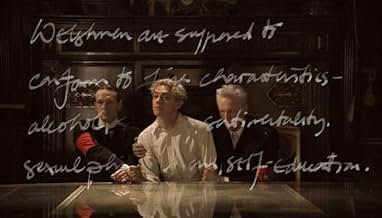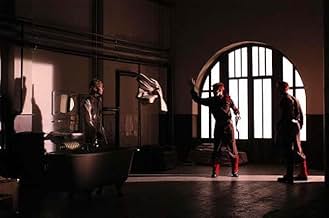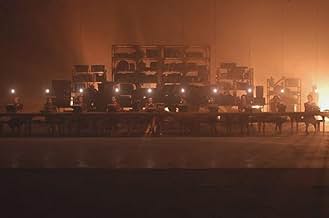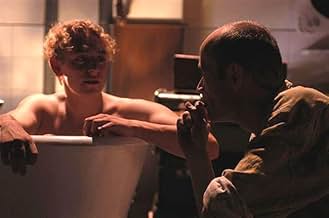Las maletas de Tulse Luper: La historia de Moab
Título original: The Tulse Luper Suitcases, Part 1: The Moab Story
PUNTUACIÓN EN IMDb
6,7/10
1,3 mil
TU PUNTUACIÓN
Tulse Luper de niño durante la Primera Guerra Mundial, como explorador en el Utah mormón y como escritor en Bélgica durante el ascenso del fascismo.Tulse Luper de niño durante la Primera Guerra Mundial, como explorador en el Utah mormón y como escritor en Bélgica durante el ascenso del fascismo.Tulse Luper de niño durante la Primera Guerra Mundial, como explorador en el Utah mormón y como escritor en Bélgica durante el ascenso del fascismo.
- Dirección
- Guión
- Reparto principal
- Premios
- 1 premio y 1 nominación en total
Jordi Mollà
- Jan Palmerion
- (as Jordi Molla)
Nilo Zimmermann
- Pip
- (as Nilo Mur)
Reseñas destacadas
Peter Greenaway likes drugs and attempting to differentiate his movies from others. I've seen a few of his other movies before this one and I'm really not much of a fan. I simply don't care for his style but I still respect him somewhat as he doesn't seem to care about living up to peoples expectations. He seems to have plenty of original ideas but it seems as if he never seems to care about perfecting them and bring them out in the most cockneyest of ways. With that said this (along with the whole project) to me doesn't seem much more than a concept... most of the effects (some of which have been used by Greenaway in his previous films) aren't used to their full potential but are used well enough to prove that they can. This might not be an excellent film but it certainly isn't a bad one.
I watched this several months ago at a local film festival, and to be honest it was not an enjoyable experience. To put it simply the film appears to be a giant experiment in multimedia, the type of thing a film studies phd student might envisage as being worthwhile. If you are fully aware of this before you watch the first film then you may possibly appreciate the work done, if you are looking for something enjoyable then I suggest you look elsewhere. The film oosed pretension, as if the mere act of experimentation could make up for a worthwhile film. If you are the type of watcher who enjoys say special affects rather than plot, or action rather than competent script work then this may be for you.
This is the first film that I have watched at a film festival in about ten years that I can honestly say the vast majority of the audience left the theatre in a state of bemused disgust. It was one of the least enjoyable film experiences I have ever had, right up there with Salo, and UFO: The Movie. Maybe if viewed in sequence with the other parts of the production it might have some worth, but i doubt it. At best it may serve as an educational tool to the many film schools out there...
This is the first film that I have watched at a film festival in about ten years that I can honestly say the vast majority of the audience left the theatre in a state of bemused disgust. It was one of the least enjoyable film experiences I have ever had, right up there with Salo, and UFO: The Movie. Maybe if viewed in sequence with the other parts of the production it might have some worth, but i doubt it. At best it may serve as an educational tool to the many film schools out there...
The Moab Story is a fascinating cinematic experiment - it really is an encyclopedic CD-ROM-like film - it reminded me of The Pillow Book and A TV Dante in its presentation. The screen is predominantly busy with informative movement. I watched the film on DVD and the text on screen is small, but I was constantly zooming in on the picture to read it so it wasn't a problem. But the viewing would be enhanced watching it on as large a screen as possible, but having said that it is appropriate for DVD with its interactivity. The project as a whole begs for interactivity with the individual user.
The film begins with showing us actors auditioning for roles, which is also used later. Tulse is a young boy with his friend Martino Knockavelli in the back yard of his house in Newport, Wales. A red brick wall collapses on Tulse and then we progress through history, with war footage in the background. Tulse travels to Moab where he is abused and jailed, and then later travels to Antwerp and faces the sinister Red Fox fascists. Throughout the film a small box with the head of a talking expert inside appears (like A TV Dante) describing the background of what is happening. Characters are noted on screen with name and number when they appear. It was fun reading all of Luper's Lost Films that scrolled down the screen, as well as seeing the other suitcases (suitcases 1 - 21 are featured in this film). It was good to see former Greenaway films - Vertical Features Remake, Water Wrackets, A Zed & Two Noughts, and The Belly of an Architect - referenced and appear. Greenaway is really experimenting here with image and sound, using repetitive sound at times giving an echoing effect. He plays with connecting numbers to draw shapes on screen when Percy strikes Tulse. Sometimes the screenplay is shown on screen after the characters have said it. The cinematography by Reinier Van Brummelen is good. The music by Borut Krzisnik is superb and feels appropriate. In the acting stakes Caroline Dhavernas is the stand out, and J.J. Feild does a capable job as Tulse. It's a film that (like all Greenaway films) needs to be watched several times. I look forward to seeing Vaux to the Sea.
The film begins with showing us actors auditioning for roles, which is also used later. Tulse is a young boy with his friend Martino Knockavelli in the back yard of his house in Newport, Wales. A red brick wall collapses on Tulse and then we progress through history, with war footage in the background. Tulse travels to Moab where he is abused and jailed, and then later travels to Antwerp and faces the sinister Red Fox fascists. Throughout the film a small box with the head of a talking expert inside appears (like A TV Dante) describing the background of what is happening. Characters are noted on screen with name and number when they appear. It was fun reading all of Luper's Lost Films that scrolled down the screen, as well as seeing the other suitcases (suitcases 1 - 21 are featured in this film). It was good to see former Greenaway films - Vertical Features Remake, Water Wrackets, A Zed & Two Noughts, and The Belly of an Architect - referenced and appear. Greenaway is really experimenting here with image and sound, using repetitive sound at times giving an echoing effect. He plays with connecting numbers to draw shapes on screen when Percy strikes Tulse. Sometimes the screenplay is shown on screen after the characters have said it. The cinematography by Reinier Van Brummelen is good. The music by Borut Krzisnik is superb and feels appropriate. In the acting stakes Caroline Dhavernas is the stand out, and J.J. Feild does a capable job as Tulse. It's a film that (like all Greenaway films) needs to be watched several times. I look forward to seeing Vaux to the Sea.
The Moab Story is part 1 of a 3 part, 6 hour film tracing the life of the eponymous Tulse Luper and, for reasons not yet clear, the history of Uranium (atomic number 92 - this is important so pay attention at the back).
Greenaway continues to evolve his directorial style, overlapping images and sounds, embedding windows within windows, mixing media. The results are often confusing, sometimes stunning, never boring.
I wondered if Greenaway was hinting that this was in some sense an autobiographical piece. Tulse Luper is cited as the author of 'The Belly of an Architect' and in a list of his lost works appears 'The Falls', both earlier films by Greenaway.
Of course it might just be the director playing games. A clip from 'A Zed and Two Noughts' is used at one point, and there is a character named 'Cissie Colpits', the name of the three women in 'Drowning by Numbers'. I suspect there might well have been many more references to earlier films in there.
This is closer in style to 'Properos Books' or 'A TV Dante' than some of his earlier works such as 'The Cook, the Thief, his Wife and her Lover'. Narrative flow has been sacrificed in part for creating a cinematic work of art. Nothing wrong with that in my opinion though, when the result is a film like this. Sit back and let the experience wash over you.
Greenaway continues to evolve his directorial style, overlapping images and sounds, embedding windows within windows, mixing media. The results are often confusing, sometimes stunning, never boring.
I wondered if Greenaway was hinting that this was in some sense an autobiographical piece. Tulse Luper is cited as the author of 'The Belly of an Architect' and in a list of his lost works appears 'The Falls', both earlier films by Greenaway.
Of course it might just be the director playing games. A clip from 'A Zed and Two Noughts' is used at one point, and there is a character named 'Cissie Colpits', the name of the three women in 'Drowning by Numbers'. I suspect there might well have been many more references to earlier films in there.
This is closer in style to 'Properos Books' or 'A TV Dante' than some of his earlier works such as 'The Cook, the Thief, his Wife and her Lover'. Narrative flow has been sacrificed in part for creating a cinematic work of art. Nothing wrong with that in my opinion though, when the result is a film like this. Sit back and let the experience wash over you.
I saw this film last night at the Hirshhorn Museum in Washington DC. Antwerp was also shown, I believe. Peter Greenaway was there, presented comments before the film, between the films, and answered questions after the film. It started about 8PM, and when I left around 1AM, Greenaway was still answering questions. The film was shown in high definition, although the Hirshhorn projection system sometimes had trouble keeping it in focus. Antwerp repeated about twenty-five minutes of the end of Moab.
I won't attempt to describe much of the plot of Greenaway's mad project, such as I saw it, other than to say it traces the life of the title character through the two world wars of the twentieth century. If it is ever completed, one would expect there to be ninety-two "suitcases", hyperlinks as it were, to elements of Tulse Luper's life; one would expect there to be ninety-two common archetypical objects representing human existence; and one would expect there to be ninety-two characters in the movie, many of whom are introduced in split screen "auditions", which Greenaway imagined are analogous to parallel worlds. However, other than the number of times Tulse is physically assaulted, I can't recall any of the numbers going beyond thirty, so clearly there is a long way to go before the film can ever be called completed.
Greenaway described his visual metaphor as capturing elements of toolkits from multimedia computer graphics. The influence of a high bandwidth internet experience is also present. There was something analogous to a magnifier icon for creating a box around an element of a scene to be highlighted. There were panels of foreground videos playing over a background video reminiscent of a Windows Media Player or a Real Player. And there was one scene that split and adjusted the frame of the movie horizontally, like something I'd seen editing a Word document. Of course, all of these elements are subtly redefined to be nonobvious, and graphically balanced and symmetric. In one of the most visually impressive sequences in the film, the camera moves slowly from left to right, and then back, over a row of typists, each of whom has a bare light bulb above her head, and between each of them there is a semi-transparent display of rapidly changing document pages as might be scanned from a database.
Thematically, the film captures the best elements of Greenway. He said he expected Tulse Luper to be his magna opus, and the way he described the infinitely recursive structure of the story, it is likely to be an unfinished symphony. The numbers from Drowning by Numbers are here. The brutality of The Cook the Thief His Wife & Her Lover is, too. The film is expressly referential to Greenaway's earlier works, and he suggests that Tulse Luper is his alter ego.
Greenaway makes much of the architectural elements of the frame -- the Cartesian grid, lots of horizontal and vertical lines, vanishing perspectives, conic shadows of divergent illumination from a point source -- but for me what makes Greenaway Greenaway is brutality for an underlying theme, and lots of artfully naked, sexually expressive people. The visual elements could certainly exist without the rawness, but his films would not be as powerful without it. One scene clearly showed the results of a castration, and many others involved some sort of sexual domination. Greenaway said he is an atheist; I wondered, is he also a practitioner of sexual dominance in his personal life, or is he just doing this to be interesting? Between films, Greenaway sounded almost apologetic in explaining it was about totalitarianism and anti-semitism, but it's problematic for a Britisher in our age of anti-Americanism to present so many fascist characters uttering slurs against the Jews. It's sort of like Shakespeare's Merchant of Venice talking about the Holocaust. Does repeating blood libels, like the Jews supposedly being responsible for communism, somehow perpetuate the injury? Early in the film, a character repeats a mantra to "destroy the evil" as a way presumably to end war, but then later another suggests this sounds like too much of a violent thing to do; one wonders, which is it?
This was certainly the most powerful movie experience I had in 2003, although admittedly I didn't see very many good movies this year. And the scale of Tulse Luper is such that I'm sure it will be one of Greenaway's very best, even if it never achieves a state of completion. It helps vastly of course to see it in the theater and in high definition. While Greenaway regretted the French subtitles, as the version we saw was shown at Cannes, I actually found they added another dimension to the film: not only did they help me catch what the characters were saying when they spoke too fast to hear, but the nuances of French vis-a-via English were enlightening.
I won't attempt to describe much of the plot of Greenaway's mad project, such as I saw it, other than to say it traces the life of the title character through the two world wars of the twentieth century. If it is ever completed, one would expect there to be ninety-two "suitcases", hyperlinks as it were, to elements of Tulse Luper's life; one would expect there to be ninety-two common archetypical objects representing human existence; and one would expect there to be ninety-two characters in the movie, many of whom are introduced in split screen "auditions", which Greenaway imagined are analogous to parallel worlds. However, other than the number of times Tulse is physically assaulted, I can't recall any of the numbers going beyond thirty, so clearly there is a long way to go before the film can ever be called completed.
Greenaway described his visual metaphor as capturing elements of toolkits from multimedia computer graphics. The influence of a high bandwidth internet experience is also present. There was something analogous to a magnifier icon for creating a box around an element of a scene to be highlighted. There were panels of foreground videos playing over a background video reminiscent of a Windows Media Player or a Real Player. And there was one scene that split and adjusted the frame of the movie horizontally, like something I'd seen editing a Word document. Of course, all of these elements are subtly redefined to be nonobvious, and graphically balanced and symmetric. In one of the most visually impressive sequences in the film, the camera moves slowly from left to right, and then back, over a row of typists, each of whom has a bare light bulb above her head, and between each of them there is a semi-transparent display of rapidly changing document pages as might be scanned from a database.
Thematically, the film captures the best elements of Greenway. He said he expected Tulse Luper to be his magna opus, and the way he described the infinitely recursive structure of the story, it is likely to be an unfinished symphony. The numbers from Drowning by Numbers are here. The brutality of The Cook the Thief His Wife & Her Lover is, too. The film is expressly referential to Greenaway's earlier works, and he suggests that Tulse Luper is his alter ego.
Greenaway makes much of the architectural elements of the frame -- the Cartesian grid, lots of horizontal and vertical lines, vanishing perspectives, conic shadows of divergent illumination from a point source -- but for me what makes Greenaway Greenaway is brutality for an underlying theme, and lots of artfully naked, sexually expressive people. The visual elements could certainly exist without the rawness, but his films would not be as powerful without it. One scene clearly showed the results of a castration, and many others involved some sort of sexual domination. Greenaway said he is an atheist; I wondered, is he also a practitioner of sexual dominance in his personal life, or is he just doing this to be interesting? Between films, Greenaway sounded almost apologetic in explaining it was about totalitarianism and anti-semitism, but it's problematic for a Britisher in our age of anti-Americanism to present so many fascist characters uttering slurs against the Jews. It's sort of like Shakespeare's Merchant of Venice talking about the Holocaust. Does repeating blood libels, like the Jews supposedly being responsible for communism, somehow perpetuate the injury? Early in the film, a character repeats a mantra to "destroy the evil" as a way presumably to end war, but then later another suggests this sounds like too much of a violent thing to do; one wonders, which is it?
This was certainly the most powerful movie experience I had in 2003, although admittedly I didn't see very many good movies this year. And the scale of Tulse Luper is such that I'm sure it will be one of Greenaway's very best, even if it never achieves a state of completion. It helps vastly of course to see it in the theater and in high definition. While Greenaway regretted the French subtitles, as the version we saw was shown at Cannes, I actually found they added another dimension to the film: not only did they help me catch what the characters were saying when they spoke too fast to hear, but the nuances of French vis-a-via English were enlightening.
¿Sabías que...?
- Curiosidades'Cissie Colpitts' is the name shared by the three main female characters in Conspiración de mujeres (1988), by the same director.
- ConexionesEdited into The Tulse Luper Suitcases: Antwerp (2003)
Selecciones populares
Inicia sesión para calificar y añadir a tu lista para recibir recomendaciones personalizadas
- How long is The Tulse Luper Suitcases, Part 1: The Moab Story?Con tecnología de Alexa
Detalles
- Fecha de lanzamiento
- Países de origen
- Sitio oficial
- Idiomas
- Títulos en diferentes países
- Les maletes de Tulse Luper: La història de Moab
- Localizaciones del rodaje
- Empresas productoras
- Ver más compañías en los créditos en IMDbPro
Taquilla
- Presupuesto
- 10.000.000 US$ (estimación)
- Recaudación en todo el mundo
- 90.071 US$
- Duración2 horas 7 minutos
- Color
- Mezcla de sonido
- Relación de aspecto
- 1.85 : 1
Contribuir a esta página
Sugerir un cambio o añadir el contenido que falta



































